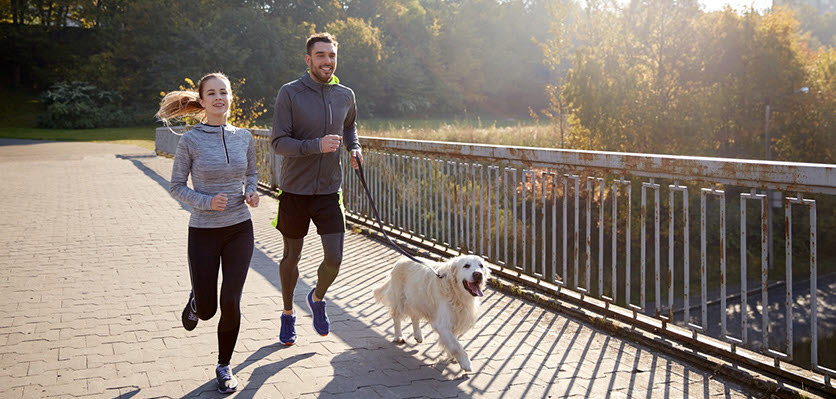
Physical activity is just as important for our pets as it is for us, but there are a few things to keep in mind before starting on your fitness journey.
Read our five tips below to learn how to exercise with your dog safely.
1. Make time for a fitness check up
Just as it would be unwise for you to run 10km without any training, dogs should ease into any exercise or training program to avoid unwanted injuries.
If your dog is overweight or obese, it’s particularly important to seek guidance from your veterinarian before starting an exercise program. Older dogs or those with pre-existing conditions should also see a veterinarian before starting exercise regimes.
If weight loss for your dog is a goal, consider bringing your dog in for weekly weigh-ins at your veterinary clinic, and seek advice from your veterinarian on weight loss diets to be used in conjunction with exercise.
2. Exercise equipment
When exercising your dog, whether it’s a long run in the park or playing frisbee at the beach, there is a range of equipment that can be used.
Unless you’re in a designated off-leash area, you should always keep your dog on a lead when exercising in public.
Attaching the lead to a comfortable fitting harness is the best option when running with dogs. There are even wearable technology options for dogs now, such as the FitBark which monitors your dog’s activity and sleep levels.
3. Keeping cool when exercising
It’s vital to keep cool during exercise to avoid overheating. Exercising your dog in the cool of the morning or late at night is one way to avoid the brutal summer sun. Avoid exercising during heat waves, even at night, and just stick with short walks instead.
Keep exercise sessions short during summer and consider incorporating water into your workouts, such as swimming in a creek or playing fetch in the water. Always ensure your dog has plenty of water to drink before and after exercising and keep a close eye on them at all times.
If your dog is showing any signs of heat stress, such as panting heavily and incessantly, salivating excessively, collapse, brick red gums or heavy breathing, stop exercising and start cooling your dog immediately. Seek shade, use water to dampen them and ring your veterinarian for advice straight away.
4. Breeds to keep an extra close eye on
Some dog breeds struggle to keep cool, even on normal days, so it’s best to avoid intensely exercising these dogs at all during summer.
Dog breeds at high risk of heat stress include the brachycephalic or flat-faced breeds like French bulldogs, British bulldogs and pugs.
If you have one of these breeds and are worried about their breathing, make an appointment with your veterinarian today. More information on the specific risks these dogs face can be found here.
5. Exercise is not an alternative to walks
Although it can be fun to get fit with your dog, a run with your dog shouldn’t be an alternative to their daily walk. Walking your dog gives them the chance to sniff and explore their neighbourhood, with smell being one of their most important senses.
Just as we like to catch up on gossip by chatting with neighbours, dogs greatly enjoy sniffing and marking their territory regularly. Consider using their walk as a cool down to your run!
Whether you go high tech or keep it simple, exercising with your dog can be great fun and good for both you and your pet. Follow our tips to ensure your exercise adventures stay safe and fun.
